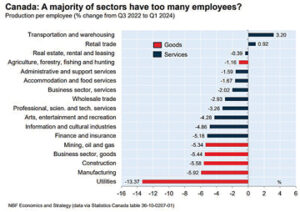Jobs
Economics 101: The deteriorating fundamentals of the Canadian job market – Medicine Hat News

By Eric Van Enk on July 27, 2024.
 Source: National Bank Financial
Source: National Bank FinancialThe most recent Canadian employment data was disappointing from several perspectives. The data for June (released early July) disappointed in terms of the number of jobs created as well as the overall unemployment rate which increased by 20 basis points to 6.4%. Most of this increase was due to Canada’s population growth (i.e. population growth outpacing job growth). I found this week’s chart interesting because it highlights what is known as the ‘law of diminishing returns’ in economics and provides insight into the near-term direction of the Canadian unemployment rate.
Investopedia defines the law of diminishing returns as, “a theory in economics that predicts after some optimal level of capacity is reached, adding an additional factor of production will result in smaller increases in output.”
For example, a business can grow its sales by adding employees to a certain point, at which time, hiring additional employees does little (or nothing) to increase sales. This week’s chart segments the Canadian economy into sectors, highlighting ‘Goods’ sectors in red, while ‘Services’ sectors are highlighted in blue.
The bars represent the change in productivity per employee from the third quarter of 2022 to the first quarter of this year. Notice all but two sectors (Transportation & Warehousing and Retail Trade) have shown a negative change in production per employee over that time frame. In other words, 15 of the 17 sectors of the Canadian economy are exhibiting the law of diminishing returns as it pertains to employees – additional employees are adding less to production/sales.
This isn’t good and typically occurs as an economy crests. As the economy grows, businesses add more employees to help grow production /sales.
However, at some point, the business reaches an optimal level of employees which means that for each additional employee hired, the company’s sales will increase by a decreasing amount (or not at all).
This employment statistic can be viewed as a leading indicator of future job creation or losses. Logically, if production gains per employee are positive as they are in the two sectors at the top of the chart, businesses in those sectors (Transportation & Warehousing and Retail Trade) have an incentive to hire more people. Conversely, businesses in the other 15 sectors of the economy have less incentive to hire because recent additions to their workforce haven’t meaningfully increased sales.
Furthermore, businesses which are experiencing the law of diminishing returns for employees are likely to be the first to reduce their workforce if they experience a decline in sales (i.e. firing people may reduce costs more than it reduces sales).
What are your thoughts? I’d love to hear from local business owners on this subject – are you experiencing diminishing returns in your workforce, or do you see the potential to increase production per employee? Does the chart which shows trends at a national level ‘ring true’ to what you’re experiencing at a local level?
Eric Van Enk is a wealth adviser & associate portfolio manager with National Bank Financial in Medicine Hat. He is a graduate of the University of Calgary, as well as a CFA charter holder with 20 years of financial markets experience in New York, Toronto and Calgary. He can be reached at eric.vanenk@nbc.ca
11
-10










